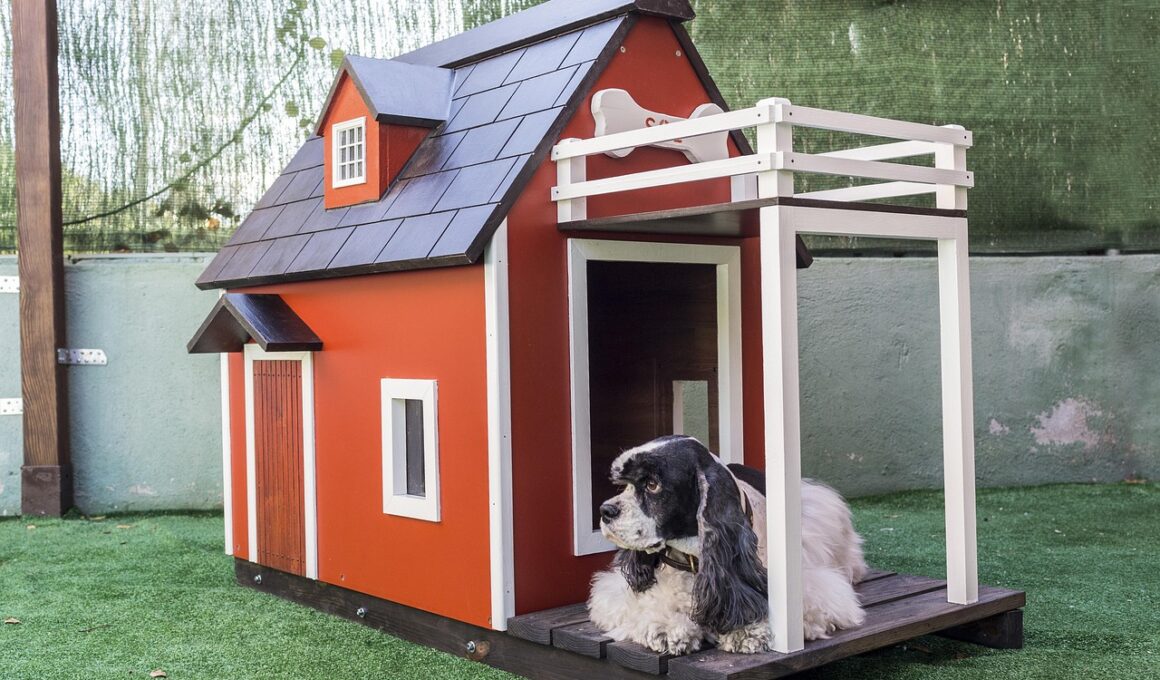Seasonal Dog Housing Adjustments for Breed Comfort
Taking into account the various breeds when it comes to dog housing during seasonal changes is incredibly important. Each breed has unique characteristics and needs, which may change depending on the season. For instance, breeds with thick fur, like Huskies, thrive in colder weather and may require less insulation compared to short-haired breeds such as Greyhounds that are prone to colder temperatures. It’s crucial to enhance their comfort according to their requirements and the weather conditions. When considering insulation for a dog house, choose materials appropriate for the breed. Adequate ventilation also plays a significant role in keeping dogs cool during warmer months. This can include design choices, such as windows or vent holes. Other factors include creating shaded areas with trees or tarps, ensuring that they can avoid direct sunlight and heat while resting. Moreover, making sure that the floor remains dry and comfortable is essential for their health. Adding bedding or straw can provide further comfort. Adjusting housing conditions by adding or removing insulation helps in maintaining an optimal environment for your furry friends.
Building a cozy indoor space for your dog is beneficial as the seasons change. For indoor spaces, consider using temperature regulation—either heating or cooling options. Some breeds, particularly those with thin coats or smaller body sizes, can be significantly more affected by cold temperatures and may require a heated area indoors during extreme winter months. Dog blankets and pads can aid in cozying up their indoor space. On the flip side, cooling mats or air conditioning units might become essential for breeds like French Bulldogs or Pugs that can’t regulate heat effectively. If you decide to use electric devices, always make sure they are safe for pets. Outdoor dog houses should be placed strategically to maximize shade from trees, minimizing exposure to direct sunlight and making sure they are elevated to prevent flooding from rain or snow. Adding a water source nearby ensures hydration is easily accessible for your dog. Heavier breeds or those more prone to heat stress require extra precautions. Consider revamping the outdoor spaces in summer or winter to provide comfort. Always observe your dog’s behavior to make sure they’re feeling comfortable throughout the seasons.
Adjustments for Cold Weather
When winter arrives, the demand for protective housing for dogs increases, especially for more sensitive breeds. For small or short-haired breeds, ensure their shelter is insulated and protected from freezing temperatures. Materials like Styrofoam or insulated panels are ideal for creating snug housing. Of equal importance is the need for raised floors, which can keep the dog off the cold ground and provide warmth. Additionally, adding blankets or bedding that retains body heat can offer much-needed comfort in colder months. Pay attention to the entrance of the dog house; it should ideally be sheltered from direct winds and moisture. Temporary windbreaks made of tarps or additional panels can help here. Covering the entrance with fabric can create a barrier while allowing easy access. Providing a separate space for play that remains dry is key, preventing them from getting cold and wet. Monitoring their time outside during extremely low temperatures is necessary to reduce risk. Equally, make sure food and water bowls are not freezing to ensure hydration and nourishment at all times. These simple adjustments can provide the necessary warmth and comfort for dogs in colder climates.
As dogs tend to be social animals, other factors can ensure their comfort during colder times. For instance, having more than one dog breed at home might affect housing situations considerably. Always observe how dogs react to each other, especially in shared spaces during colder months. If they tend to interact positively, they can share shelter, but it’s crucial to ensure enough space for each breed. Adjustments may also be needed in separate areas if one breed becomes more dominant or active. Having enclosures that allow for separate monitoring is key. Another aspect to consider is their bedding type; thicker and softer materials help keep them warmer. However, ensure that the bedding is also easy to clean, reducing potential allergens or sensitivities. During winter months, bathe dogs less frequently to prevent cold-related issues; however, if baths are necessary, consider ensuring they dry thoroughly indoors afterward. Beyond providing adequate space, ensuring cleanliness and comfort can create a warm atmosphere. Regular inspections of their housing throughout winter help identify any issues that may arise with insulation or areas in need of adjustments that benefit all breeds.
Adjustments for Hot Weather
The heat of summer causes a drastically different set of requirements for dog housing as opposed to winter. Notably, dogs with heavier fur, such as Newfoundlands or Bernese Mountain Dogs, may struggle with overheating. It’s essential to provide ample shade for outdoor housing to combat this. This can be done using awnings or creating shaded areas with structures. Additionally, during extreme heat, ensure proper ventilation in outdoor dog houses for comfort. Proper airflow can be improved with openings in the structure or by choosing a house elevated from the ground. Using cooling bedding materials such as gel-based pads can also be beneficial, allowing dogs to cool off effectively. Frequent water checks are necessary; dogs should stay hydrated and have access to cool, fresh water at all times. Monitoring outdoor time during the hottest part of the day can help prevent heat exhaustion, keeping dogs energetic and comfortable. Moreover, consider providing extra activities or toys that engage their minds without overexertion. Keeping your dogs entertained while maintaining a cool environment helps achieve a pleasant summer experience.
Another effective way to aid in dogs coping with the heat is by establishing a routine. Create a schedule for walks and playtime that allows for activities during cooler parts of the day, such as mornings or evenings. Providing occasional swimming experiences can also help dogs regulate their body temperature effectively in hot months. Consider doggy pools that allow them to cool down while having fun. Padded areas under shade can serve as comfortable resting spots. When creating appealing environments, constantly check for accessibility, ensuring the area remains dog-friendly. Breeds that are flat-faced, like Bulldogs, particularly struggle with heat and require close monitoring during hot seasons. Avoid long exposure during high temperatures and observe signs of overheating. Always have cooling aids on hand, such as frozen treats or fabric that can keep them cool. Heat stress can escalate rapidly and may lead to heat strokes if not monitored. Take note of their drinking habits, thirst levels, and overall energy while adapting their housing environment to sustain comfort and safety during the summer months.
General Maintenance & Seasonal Preparations
Regardless of the season, regular maintenance is critical to ensure dog housing remains functional and comfortable. Inspecting for damages caused by weather, pests, or natural wear should never be overlooked. In particular, check for any leaks, cracks, or on surfaces that may need replacing or repair. For wooden structures, applying water-resistant coatings can prolong durability against moisture. This maintenance extends the lifespan of their houses while ensuring comfort remains paramount. A preventive approach reduces costs associated with repairs and replacements. Seasonal adjustments to landscaping are equally important; avoid any obstructive growth that limits airflow or space. Trim down shrubs that may provide a harbor for pests during summer and winter months. Keeping the surroundings clean aids in pest control, allowing your dog comfort. Ideally, have protective barriers against wild animals that may be problematic, especially during nights when your dog is outdoors. Always feel empowered to adjust homes according to seasonal trends; your dog will undoubtedly appreciate your consideration. Remember, their happiness and well-being are largely influenced by the care you provide.
In conclusion, seasonal dog housing adjustments are essential for ensuring the comfort of various breeds. Always explore choices tailored to each dog’s needs based on their breed, size, and temperament. The right environment promotes positive health benefits, ensuring that dogs thrive throughout the yearly cycle. As seasons shift, remaining proactive allows for thoughtful adjustments in providing lovely spaces for canine companions. Creating comfortable environments encompasses both indoor and outdoor spaces, keeping their unique requirements in mind. It’s also helpful to create a comprehensive plan for managing heat in the summer and cold during the winter months. This includes providing adequate hydration, shade, or warmth as necessary. Monitoring behaviors and making adjustments is a significant part of pet ownership that can lead to happy pets. Furthermore, maintain awareness of the potential hazards and challenges associated with seasonal changes. Always be ready to modify aspects of their housing based on evolving conditions. As loyal companions, they trust in your ability to provide a safe and supportive environment, and in doing so, ensure they remain happy and healthy over the years.


